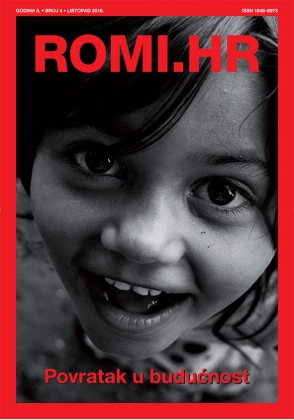Vijesti ROMI.HR
/Problem maloljetnih beskućnika je aktuelan u mnogim zemljama svijeta i definitivno zaslužuje našu pažnju. U ovom članku usredotočit ću se na situaciju u Ukrajini jer sam upoznata s tamošnjom situacijom. Ako ne poduzmemo mjere, broj maloljetnih beskućnika može dosegnuti istu razinu kao i devedesetih godina.
Prijevod: Daria Maracheva
Na svijetu žive milijuni djece čiji su životi vezani s javnim prostorima, bilo da su to ulice, napuštene zgrade, kolodvori itd. Neka od ove djece žive na ulicama i nemaju drugo prenoćište. Drugi možda i imaju domove, ali ovisi o ulici kako bi preživjeli.
Nazivaju ih “djecom ulice“, “maloljetnim beskućnicima“. U nekim slučajevima čak ih uvredljivo nazivaju "prosjacima" ili "lopovima". Pogrešno je etiketirati takvu djecu, jer upravo njima najviše nedostaje ljubav, podrška i briga.
31. siječanj je Međunarodni dan “djece ulice“. Ovaj poseban dan nastao je na inicijativu austrijske dobrotvorne neprofitne organizacije Jugend Eine Welt, koja je osnovana 1997. godine. Njihova misija je poticanje razvoja i obrazovanja maloljetnih beskućnika. Prikupljaju donacije za projekte na području obrazovanja, razvoja i pružanja humanitarne pomoći poput hrane, odjeće, smještaja itd. Organizacija potiče mlade ljude da pomažu jedni drugima i svima kojima je potrebna pomoć.
Problem maloljetnih beskućnika je prisutan u mnogim dijelovima svijeta i definitivno mora biti riješen. Fokusirat ću na Ukrajini, jer sam Ukrajinka. U Ukrajini je situacija s “djecom ulice“ prilično problematična.
Tokom sovjetskog razdoblja na ulicama je bilo puno djece beskućnika, posebno u razdoblju Oktobarske revolucije i građanskog rata. Prema podacima iz 1922. godine u zemlji je bilo više od 7 milijuna djece beskućnika. Nakon provođenja niza reformi situacija se popravila do 1940. godine. Međutim, nakon Drugog svjetskog rata taj broj se ponovno dramatično povećao.
Nakon 1991. godine, kad je Sovjetski Savez raspao, u tranzicijskom razdoblju, tisuće djece su ostale zanemarene. Životni uvjeti pogoršali su se i broj maloljetnih beskućnika povećao se u odnosu na prethodno razdoblje.
Danas je situacija u Ukrajini bolja, ali prije nekoliko godina započeo je novi val maloljetnjičkog beskućništva. Djeca koja su živjela u obiteljima, u kojima su roditelji alkoholičari, ovisnici o drogama ili koji psihološki i fizički zlostavljaju svoju djecu, počela su bježati iz domova, a rat s Rusijom 2014. godine je još više zaoštrio situaciju.
Sada se maloljetni beskućnici mogu naći širom Ukrajine. Žive u napuštenim zgradama, jedva imaju priliku nešto pojesti jednom dnevno, rade ilegalno i samo slabo plaćene poslove i nemaju odgovarajućeg obrazovanja. Prema ukrajinskom zakonu od četrnaeste godine djeca imaju pravo obavljati lagan posao, ali samo uz pristanak roditelja. I to ne više od četiri sata dnevno. Međutim, ima djece koja rade u rudnicima i obavljaju iste poslove kao i odrasli.
Prema podacima iz razdoblja 2012-2016., od 3 do 300 tisuća maloljetnih beskućnika iz različitih područja Ukrajine korišteni su kao radna snaga. Vlada je predložila niz programa usmjerenih na riješavanje ovog problema, od kojih do sada nijedan nije proveden. Raspravljajući o ovom pitanju, Jurij Pavlenko, narodni zastupnik, kojeg je bivši predsjednik Ukrajine Viktor Janukovič imenovao pravobraniteljem za djecu, izjavio je: „Ako se situacija ne promijeni, broj maloljetnih beskućnika može dosegnuti razinu iz devedesetih godina. U to vrijeme deseci tisuća djece živjeli su na ulici."
Nažalost, problem “djece ulice“ je još veći za romsku djecu u Ukrajini, čiji roditelji desetljećima žive u siromaštvu. Ekonomska i socijalna situacija toliko je loša da su romska djeca prisiljena prositi po ulicama, a mnoga djeca čak nemaju smještaj s osnovnim uvjetima. Takva djeca na kraju postanu nepismena jer ne mogu redovito pohađati školu. Najveći broj Roma živi u Odesi i Zakarpatskoj regiji u Ukrajini. Mnoga romska djeca prisiljena su prositi po ulicama, skupljati metal ili boce da bi ih zamijenila za kovanice. Nažalost, socijalne službe i vlasti ne pomažu romskoj djeci kako bi im poboljšali život.
U Ukrajini ima puno maloljetnih beskućnika, od kojih su mnogi Romi. Vlada mora predložiti novi program namjenjen za djecu beskućnike u Ukrajini. Vlasti moraju napraviti detaljan radni plan, osigurati sredstva, privući socijalne radnike, psihologe, nabaviti lijekove i sagraditi nova sirotišta kako bi smjestile maloljetne beskućnike i omogućile im socijalizaciju u društvu.
The problem of street children is actual in many places of the world and it definitely deserves our attention. In this article, I will be focusing on the situation in Ukraine as I am familiar with the situation there. If we do not do something about it, the number of homeless children could raise to the same level as in the 90s.
In the world, there are millions of children whose lives are connected to public spaces, whether it is streets, abandoned buildings, stations of public transport, etc. Some of these children live on the streets and have no other place to stay. Others may have homes, but they rely on the streets for survival.
They are called ‘street children’, ‘homeless youth’. In some cases, they are even called with a very negative connotation as ‘beggars’ or ‘thieves’. It is wrong to put such labels on these children because they are those who have a lack of love, support and care the most.
January 31 is recognized as the International Day for Street Children. This special day came to existence from the Austrian charitable non-profit organization Jugend Eine Welt, which was founded in 1997. Its mission is to encourage development and education for street children. They collect donations and contributions for education, development and emergency relief projects such as food, clothing, shelter, etc. The organization encourages young people to help one another and help youth in need.
Such a problem is actual in many parts of the world and definitely deserves attention in order to be reduced. I will focus on the specific case of street children in Ukraine because my origin is Ukrainian. In Ukraine, the situation with street children is quite problematic.
During the Soviet Union fell down there were so many homeless children, especially in the period of the October revolution and Civil War. According to the data from 1922, there were more than 7 million homeless children. After some reforms were done the situation improved by 1940. However, after World War 2 this number raised dramatically again.
After 1991, when the Soviet Union fell down, in the transition period, thousands of children were ‘left behind’. Life conditions became worse and the number of homeless children increased in comparison to the previous period.
Nowadays, the situation in Ukraine is better, but there was a new wave of children appearing on the streets a few years ago. Children who lived in families, where parents were alcoholics, drug addicts, psychological and physical abusers started escaping from homes and the war with Russia in 2014 added even more to that.
Now there are homeless children all around Ukraine. They live in abandoned places, barely have an opportunity to eat once a day, work illegally at low-paid jobs and do not have a proper education. According to the law of Ukraine - from the age of 14, children have the right to easy work, and only with the agreement of their parents. And no more than four hours a day. There are children working in the illegal mines doing the same job as adults.
According to the data from period 2012-2016, there are from 3 to 300 thousand children who live on the street in different regions of Ukraine, so they become a resource of labor for employers. The Government came up with some programs to deal with such issues, but until now they are not implemented. Debating this issue, Yuriy Pavlenko, people's deputy, authorized by the former president of Ukraine Viktor Yanukovych for children's rights, mentioned: “If the situation does not change, the number of homeless children could rise to the level of the 90s. At that time tens of thousands of children lived on the street.“
Unfortunately, such an issue is an even bigger problem for Roma children in Ukraine, whose parents live in poverty for decades. The economic and social situation is so bad that Roma children are forced to beg on the streets and many children do not even have a place with basic conditions to stay. Such kids end up being illiterate because of not being able to go to school on a regular basis. The biggest number of Roma people live in Odesa and Transcarpathian region in Ukraine. Many Roma children have to beg on the streets, collect metal or bottles to exchange them for some coins. And, unfortunately, social services and authorities do not help Roma children in order to make their life better.
There are so many children without a home in Ukraine, many of them are Roma. The government must make a new special program created for street children in Ukraine. They must create an exact working plan, funding, social workers, phycologists, medicine provided and new orphanages built in order to help homeless children to accommodate and socialize in society.














